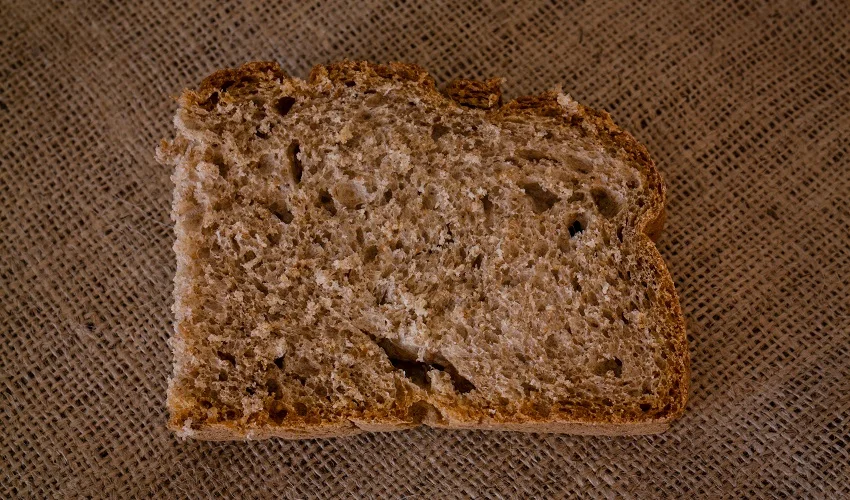Introduction to brown bread
Brown bread is a type of bread that is made from whole wheat flour, which contains more nutrients and fiber compared to white bread. It is often considered a healthier option, especially for individuals with diabetes. The high fiber content in brown bread helps regulate blood sugar levels and improve digestion. Additionally, it provides a steady release of energy and keeps you feeling fuller for longer. In this article, we will delve into the various aspects of brown bread and its impact on health, specifically focusing on its benefits and considerations for individuals with diabetes.
Nutritional value of brown bread
Brown bread is a nutritious option for individuals with diabetes due to its high fiber content. It is a rich source of complex carbohydrates, which helps in regulating blood sugar levels and providing sustained energy. Additionally, brown bread contains essential vitamins and minerals, such as B vitamins, iron, and magnesium, which are important for overall health. The fiber in brown bread also aids in digestion and promotes a feeling of fullness, making it a satisfying choice for those looking to manage their weight. Overall, incorporating brown bread into a diabetic diet can contribute to improved blood sugar control and overall well-being.
Health benefits of brown bread
Fiber is important for maintaining a healthy digestive system and can help prevent constipation. Additionally, brown bread is often made from whole grains, which provide essential nutrients such as vitamins, minerals, and antioxidants. These nutrients are beneficial for overall health and can help reduce the risk of chronic diseases, including diabetes. For individuals with diabetes, brown bread may be a better choice as it has a lower glycemic index compared to white bread, meaning it causes a slower rise in blood sugar levels. However, it is important to note that portion control and overall dietary balance are key when incorporating brown bread into a diabetic meal plan.
Understanding Diabetes
What is diabetes?
Diabetes is a chronic medical condition that affects the body’s ability to regulate blood sugar levels. It occurs when the pancreas does not produce enough insulin or when the body cannot effectively use the insulin it produces. There are two main types of diabetes: type 1 and type 2. Type 1 diabetes is an autoimmune disease that usually develops in childhood or adolescence, while type 2 diabetes is more common in adults and is often associated with lifestyle factors such as obesity and poor diet. Both types of diabetes require careful management to prevent complications and maintain overall health.
Impact of diabetes on health
Diabetes has a significant impact on overall health. It affects various systems and organs in the body, leading to complications if not managed properly. One of the key considerations for individuals with diabetes is their diet. Making healthy food choices is crucial to control blood sugar levels and prevent further health issues. When it comes to bread, especially brown bread, diabetic individuals need to be cautious. While brown bread is often considered a healthier option due to its higher fiber content, it still contains carbohydrates that can affect blood sugar levels. Therefore, it is important for diabetics to monitor their portion sizes and choose whole grain bread options in moderation.
Effects of Diet on Diabetes
Importance of diet for diabetics
A healthy diet plays a crucial role in managing diabetes, and it is especially important for individuals with diabetes to pay close attention to their food choices. For diabetics, maintaining stable blood sugar levels is essential, and the right diet can help achieve this goal. When it comes to bread, brown bread is often recommended for diabetics due to its higher fiber content and lower glycemic index compared to white bread. The fiber in brown bread slows down the digestion and absorption of carbohydrates, preventing rapid spikes in blood sugar levels. Additionally, brown bread is a good source of complex carbohydrates, which provide sustained energy and help control appetite. However, it is important to note that portion control is still key, as even brown bread can raise blood sugar levels if consumed in excess. Therefore, it is important for diabetics to work with a healthcare professional or a registered dietitian to create a personalized meal plan that includes appropriate portions of brown bread and other nutritious foods.
Carbohydrates and blood sugar levels
Carbohydrates play a crucial role in determining blood sugar levels, especially for individuals with diabetes. When consumed, carbohydrates are broken down into glucose, which is the primary source of energy for the body. However, not all carbohydrates are created equal. Brown bread, being a complex carbohydrate, is generally considered a better option for individuals with diabetes as it has a lower glycemic index compared to white bread. This means that it causes a slower and more gradual rise in blood sugar levels, helping to maintain stable glucose levels throughout the day. Additionally, brown bread is rich in fiber, which aids in digestion and can help regulate blood sugar levels. Therefore, incorporating brown bread into a diabetic diet can be a beneficial choice for managing blood sugar levels effectively.
Choosing the right bread for diabetics
When it comes to choosing the right bread for diabetics, brown bread is often recommended. Brown bread is made from whole grains, which are rich in fiber and have a lower glycemic index compared to refined white bread. This means that brown bread can help regulate blood sugar levels and prevent spikes in glucose. Additionally, the fiber in brown bread promotes satiety and can aid in weight management, which is important for individuals with diabetes. However, it’s important to note that portion control is still key when consuming brown bread, as it does contain carbohydrates that can affect blood sugar levels. Overall, brown bread can be a healthier choice for diabetics, but it’s always best to consult with a healthcare professional or registered dietitian for personalized dietary recommendations.
Brown Bread vs White Bread
Differences in nutritional content
When comparing brown bread to white bread, there are significant differences in nutritional content. Brown bread is made from whole wheat flour, which contains the bran, germ, and endosperm of the grain. This means that it is higher in fiber, vitamins, and minerals compared to white bread, which is made from refined wheat flour. The higher fiber content of brown bread can help regulate blood sugar levels and improve digestive health, making it a better choice for individuals with diabetes. Additionally, brown bread has a lower glycemic index, which means it causes a slower and more gradual rise in blood sugar levels compared to white bread. Overall, choosing brown bread over white bread can be beneficial for individuals with diabetes due to its higher nutritional content and lower impact on blood sugar levels.
Impact on blood sugar levels
Brown bread has a significant impact on blood sugar levels, especially for individuals with diabetes. Unlike white bread, which is made from refined grains, brown bread is made from whole grains that contain more fiber. This high fiber content slows down the digestion and absorption of carbohydrates, leading to a slower and more gradual rise in blood sugar levels. This can be beneficial for people with diabetes as it helps to prevent sudden spikes in blood sugar. Additionally, the fiber in brown bread also promotes satiety and can help control appetite, further contributing to better blood sugar management.
Health implications for diabetics
When it comes to brown bread, diabetics need to consider its health implications. Brown bread is generally considered a healthier alternative to white bread due to its higher fiber content. The fiber in brown bread can help regulate blood sugar levels and improve insulin sensitivity. Additionally, brown bread is often made from whole grains, which provide essential nutrients and have a lower glycemic index compared to refined grains. However, diabetics still need to consume brown bread in moderation and monitor their blood sugar levels to ensure it does not negatively impact their health.
Benefits of Brown Bread for Diabetics
High fiber content
Brown bread is known for its high fiber content, which makes it a great choice for individuals with diabetes. Fiber helps regulate blood sugar levels by slowing down the absorption of carbohydrates. This can prevent spikes in blood sugar levels and promote better glycemic control. Additionally, the high fiber content in brown bread can aid in digestion and promote a feeling of fullness, which can be beneficial for weight management. Including brown bread in a diabetic diet can provide essential nutrients and contribute to overall health and well-being.
Slow release of carbohydrates
Brown bread is considered to be a good option for individuals with diabetes due to its slow release of carbohydrates. Unlike white bread, which is made from refined flour, brown bread is made from whole grains that are rich in fiber. This fiber helps to slow down the digestion and absorption of carbohydrates, preventing sudden spikes in blood sugar levels. Additionally, the complex carbohydrates found in brown bread provide a steady and sustained release of energy, making it an ideal choice for individuals with diabetes who need to manage their blood sugar levels throughout the day.
Improved blood sugar control
Unlike white bread, which is made from refined grains that can cause a rapid spike in blood sugar levels, brown bread is made from whole grains that are rich in fiber. The fiber content in brown bread helps to slow down the digestion and absorption of carbohydrates, resulting in a more gradual rise in blood sugar levels. This can be beneficial for individuals with diabetes who need to manage their blood sugar levels. Additionally, brown bread is also a good source of complex carbohydrates, which provide sustained energy and help to keep blood sugar levels stable throughout the day. Overall, incorporating brown bread into a diabetic diet can contribute to improved blood sugar control and better overall health.
Summary of findings
The summary of findings reveals that brown bread can be beneficial for individuals with diabetes. It has a lower glycemic index compared to white bread, which means it causes a slower rise in blood sugar levels. Brown bread also contains more fiber and nutrients, such as vitamins and minerals, which can help regulate blood sugar levels and improve overall health. However, it is important to consume brown bread in moderation and consider other factors such as portion size and individual dietary needs. Consulting with a healthcare professional or registered dietitian is recommended for personalized advice.
Recommendations for diabetics
Diabetics should consider including brown bread in their diet due to its numerous health benefits. Brown bread is rich in fiber, which helps regulate blood sugar levels and improve insulin sensitivity. It also contains complex carbohydrates, which are digested more slowly and have a lower glycemic index compared to white bread. This means that brown bread causes a slower and more gradual increase in blood sugar levels, making it a better option for diabetics. Additionally, brown bread is a good source of vitamins, minerals, and antioxidants, which can support overall health and well-being. However, it is important for diabetics to monitor their portion sizes and choose whole grain breads that are low in added sugars and refined grains. Consulting with a healthcare professional or registered dietitian can help determine the appropriate amount of brown bread to include in a diabetic meal plan.
Final thoughts on brown bread and diabetes
In conclusion, brown bread can be a healthy choice for individuals with diabetes. Its high fiber content and lower glycemic index make it a better option compared to white bread. However, it is important to consider portion sizes and the overall carbohydrate intake when including brown bread in a diabetic diet. Consulting with a healthcare professional or registered dietitian can provide personalized guidance on incorporating brown bread into a diabetes management plan. It is also crucial to monitor blood sugar levels regularly and make adjustments as needed. With proper portion control and overall balanced eating habits, brown bread can be enjoyed as part of a well-rounded and diabetic-friendly diet.




